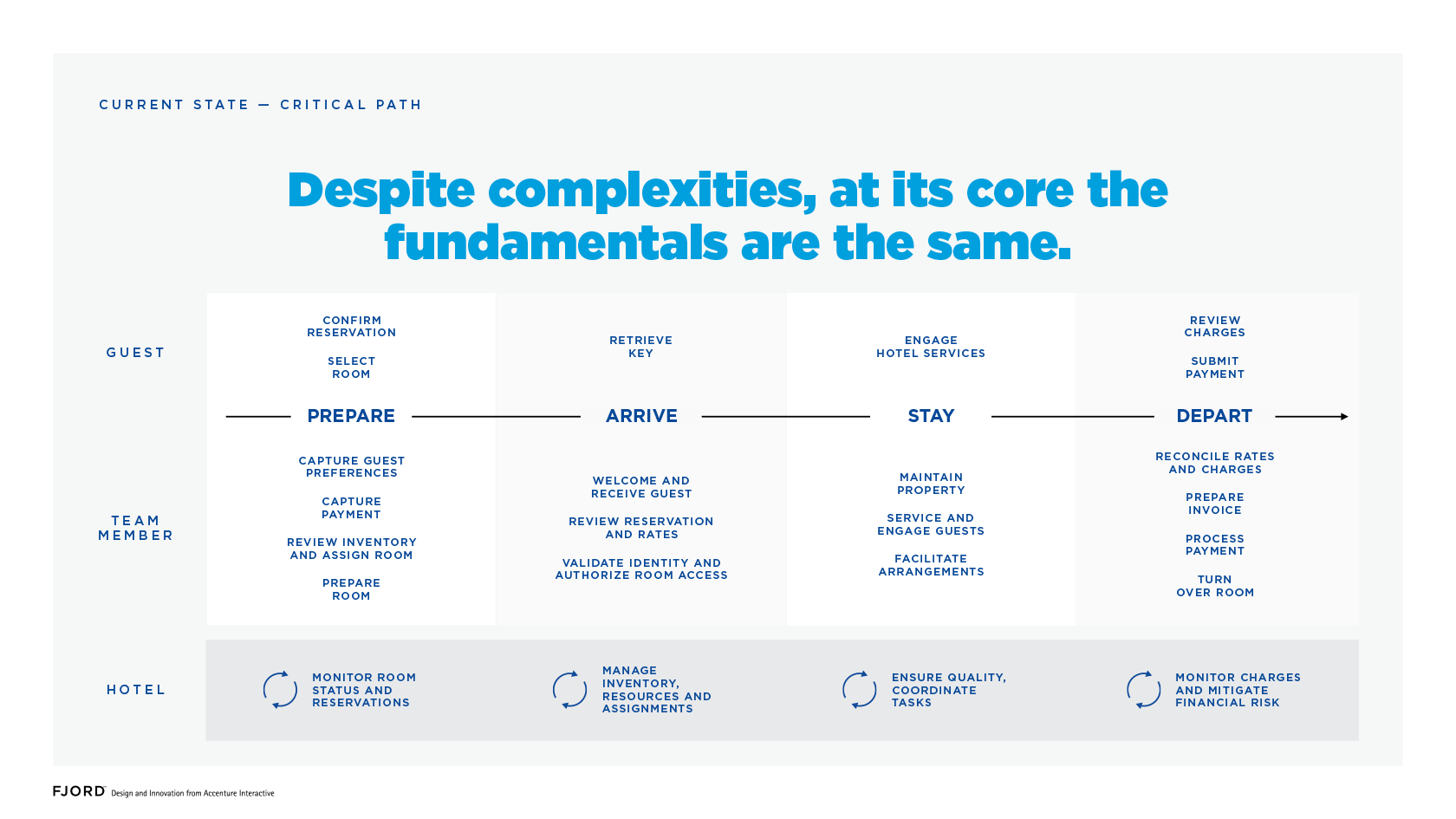Hotel Property Management System
MULTINATIONAL HOSPITALITY COMPANY
Product Management / Service Design
The current aging property system was run on-premise — requiring in-field visits for maintenance. Additionally, its dated interface acted as a burden to new staff onboarding, day-to-day operations and the customer experience.
The client looked to re-platform the property system in order to reduce the costs of upkeep. Fjord was brought on to develop a product strategy, roadmap and solution architecture for the new platform based on hotel staff and guest needs.
I served as the I served as the design lead, responsible for activities and outputs across, discovery, co-creation and alignment and solution development. The project as a whole took shape across 14 weeks, with the first 5 weeks focused on discovery and the last 8 weeks focused on solution development. I had the support of an account lead, a project manager and a team of 3 service designers. A strategy director also lent support, providing guidance as needed.
The client looked to re-platform the property system in order to reduce the costs of upkeep. Fjord was brought on to develop a product strategy, roadmap and solution architecture for the new platform based on hotel staff and guest needs.
I served as the I served as the design lead, responsible for activities and outputs across, discovery, co-creation and alignment and solution development. The project as a whole took shape across 14 weeks, with the first 5 weeks focused on discovery and the last 8 weeks focused on solution development. I had the support of an account lead, a project manager and a team of 3 service designers. A strategy director also lent support, providing guidance as needed.
The Opportunity
A leader in the hospitality industry manages more than 5,000 properties across more than 100 countries. At the heart of each property is a property management system that coordinates tasks for front desk operations and housekeeping staff.
RESPONSIBILITIES
Discovery
• Stakeholder Interviews
• Primary Research
• Journeymapping / Blueprinting
Co+Creation and Alignment
• Platform Vision + Principles
• Feature Ideation
Solution Development
• Solution Architecture
• Product Backlog / Roadmap
• Stakeholder Interviews
• Primary Research
• Journeymapping / Blueprinting
Co+Creation and Alignment
• Platform Vision + Principles
• Feature Ideation
Solution Development
• Solution Architecture
• Product Backlog / Roadmap
ROLE
Design Lead
TEAM
Strategy Director
Account Manager
Project Manager
Service Designers (3)
Account Manager
Project Manager
Service Designers (3)
Discovery
To properly tackle the platform redesign, we set out to gain a broad understanding of the business and organizational context surrounding the system re-platforming along with the current state experience of the hotel staff in day-to-day operations.
Key Insights and Core Challenges
After immersing in the subject matter and spending time embedding with hotel staff, we discovered that hotel staff worked vigilantly to make the guest experience seamless despite having to resort to manual workarounds to make it happen.
CUMBERSOME INTERFACES
Front desk operations was facilitated through interfaces that were disjointed, inconsistent, and overloaded with information.
MANUAL LOGISTICS
Housekeeping logistics was facilitated through manual workflows and disjointed communications across multiple touchpoints (ie. phone, radio, email and 3rd party platforms).
FRAGMENTED VIEW OF THE GUEST
Team members were often transacting in isolation from each other, due to the lack of a comprehensive view of the guest.

Co+Creation and Alignment
Having established key insights, we gathered stakeholders for a 2-day collaborative workshop to align against a shared platform vision. The first day was focused on immersion and alignment. The second day was focused on ideation and prioritization.

Outcomes
Commonalties across stakeholder aspirations were synthesized and distilled into a vision statement and a set of experience principles.
Against this vision, we developed a robust solution architecture and product roadmap — outlining the platform's development across rudimentary, basic, intermediate and advanced states of system maturity.
Against this vision, we developed a robust solution architecture and product roadmap — outlining the platform's development across rudimentary, basic, intermediate and advanced states of system maturity.

The platform vision described the platform's purpose, along with the core capabilities required to fulfill these functions.
The experience principles were developed against foundational qualities necessary for market relevance and transformational qualities enabling market differentiation.
The experience principles were developed against foundational qualities necessary for market relevance and transformational qualities enabling market differentiation.
VISION + PRINCIPLES

We developed a high level solution architecture outlining the capabilities and functions served by the core operations engine and its various interfaces.
Against each functional area we developed a set of process flows illustrating how the future state supported users goals, activities and tasks.
Against each functional area we developed a set of process flows illustrating how the future state supported users goals, activities and tasks.
ARCHITECTURE + CORE FLOWS

Functions and capabilities and were into staged into varying levels of maturity in a product backlog.
Relationships were drawn between functions. Together — capability maturity, feature prioritization, functional relationships and dependencies —informed the groupings governing releases.
Relationships were drawn between functions. Together — capability maturity, feature prioritization, functional relationships and dependencies —informed the groupings governing releases.
PRODUCT BACKLOG + ROADMAP
Learn more about me.







